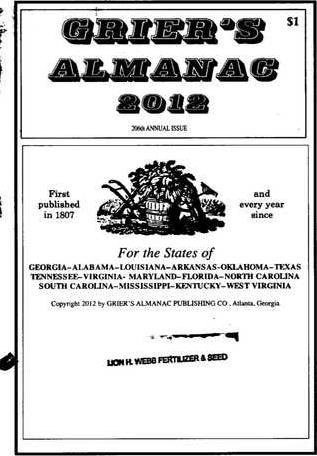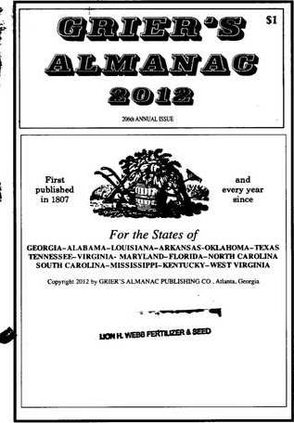Back in the antebellum days of farming in the south, an almanac was sometimes referred to as the “southern Bible.” Most households only had a few pieces of reading material. The first was of course our Christian Holy Bible. The only other things available to read in the early home would be an almanac, occasional cookbook and a few textbooks perhaps handed down from child to child.
Also spelled almanack or alamanach, the publications date to early days. The Old Farmer’s Alamanac, according to its Web site, was established 220 years ago in 1792. Founder Robert B. Thomas published this during George Washington’s term as president and each sold for about nine cents.
Originally the Griers’s Almanac, according to its Web site, was called the Georgia South-Carolina Almanack. It was founded by Robert Grier, a self educated astronomer, who had great strength in mathematics and was able to accurately predict planting guides, tides, full moons, etc. Grier’s seems to be the stronger almanac found in Georgia nowadays.
An almanac is an annual publication, often free at merchants such as pharmacies or seed and feed stores. It is available for purchase where magazines and newspapers are sold also. The book includes planting guides, moon phases, tides, fishing tips, zodiac information, chronological lists of historical events and holidays, sections on health and religion, sunrise and set times, heirloom recipes and advertisements.
A lot of the planting info is considered folklore. Many believe in certain superstitions. Some ideas included: planting that which yielded above ground produce only while the moon is waxing (on the increasing size) and planting that which yielded crops below ground product (like turnips, potatoes and carrots) while on a waning (decreasing) moon.
The ideas about harvesting had to do with yield. Picking fruit on a decreasing moon brought larger yield, better quality and longer shelf life. Root crops dug for seed had to be harvested in the third quarter of the moon phase. Cutting timber on a decreasing moon yielded wood that would decay less and not pop when burning.
Many planted in fruitful signs of the zodiac (Pisces, Taurus, Scorpio or Cancer) and never planted in the barren signs (Gemini, Leo or Virgo). Plowing, tilling and cultivating should be done on the fire sign (Aries), which was dry.
Lots of superstition preceded modern farming. Many had only a small window in which to plant corn and would wait a whole cycle of the moon if they missed their window. According to many in the area, Irish potatoes had to be in the ground by Feb. 14 to do well.
Gardens were often planted on Good Friday and this too had to do with the phase of the moon. Many with the superstitious beliefs have passed on, but some still stick to the info in the old almanac.
When you plan your next fishing trip, see what time of day the almanac predicts is better and try the information out for yourself. There is still good information in the almanacs. Why else would publications survive for 200 plus years?
This was written by Susan Exley of Historic Effingham Society. If you have photos, comments or information to share, contact Susan Exley at 754-6681 or email her at: susanexley@historiceffinghamsociety.org.








